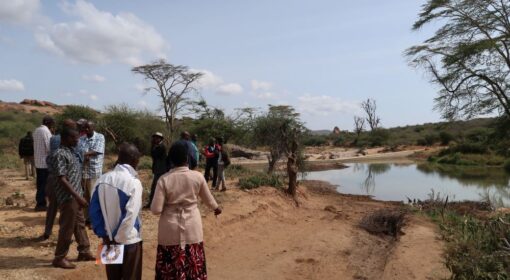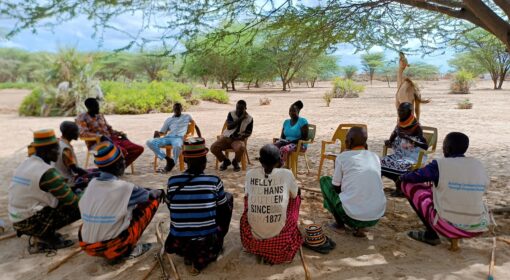IMPACT team supported by Theo Kioko
This blog is part of a dossier on locally-led adaptation, featuring insights and lessons from the Reversing the Flow (RtF) program. RtF empowers communities in Bangladesh, Burkina Faso, Ethiopia, Kenya, and Sudan to build climate resilience through direct funding and a community-driven, landscape approach.
Picture this: three neighboring communities: Mukogodo East, Mukogodo West, and Burat. Each facing drought, water scarcity, and shrinking livelihood opportunities. Through the RESTORE (Resilience Enhancement & Support through Opportunities, Resources, and Empowerment) project, supported by IMPACT Kenya, they are finding strength in cooperation.
RESTORE’s goal is to strengthen local institutions (Community Land Management Committees (CLMCs), Women Self-Help Groups, Water Resource Users Associations (WRUAs), and Community Forest Associations (CFAs)) to improve water security, climate adaptation, and livelihood diversification. The project directly regrants funds to 25 local institutions while mentoring and training their members to manage resources transparently and plan strategically. IMPACT Kenya also connects the committees with government agencies and other partners to anchor their work in broader county and national processes.

The Ward Committees
Each ward (Mukogodo West, Mukogodo East, and Burat) has its own committee made up of respected local leaders, elders, women, and youth. Members were chosen from different community groups for their integrity, peacebuilding skills, and commitment to collective progress.
These ward committees coordinate and oversee all local activities under RESTORE. They bring together diverse institutions, monitor project progress, manage sub-grants, mediate conflicts, and represent community priorities in local policy forums.
A telling example comes from Burat Ward, where a women’s umbrella group proposed distributing water tanks to all members. The committee carefully reviewed the idea and decided against it for practical reasons: most households lacked iron roofs for rainwater harvesting; the budget would not reach everyone, and overlapping memberships risked inequality. Instead, the group strengthened their Village Savings and Loan Association (VSLA) to save collectively and purchase the tanks later. This decision illustrated transparent, consultative leadership, and long-term thinking.
The Inter-Ward Committee: Connecting Communities Across Boundaries
As the RESTORE project progressed, communities recognized that issues like water scarcity, land degradation, and shifting grazing patterns extend far beyond ward borders. To address these shared challenges, an inter-ward committee was established, uniting representatives from Mukogodo East, Mukogodo West, and Burat to coordinate, learn, and advocate together.
The inter-ward committee builds on the solid foundation of the ward-level structures. While each ward committee coordinates activities among its local institutions – such as Community Land Management Committees (CLMCs), Water Committees, WRUAs, Women’s Empowerment Committees, and Youth Groups – the inter-ward committee provides oversight and alignment across the entire landscape.
Meeting quarterly, the inter-ward committee visits project sites in each ward to verify whether activities are being implemented as planned, assess progress, and jointly address emerging challenges. This shared monitoring system helps ensure that resources are used effectively, that lessons are transferred between wards, and that potential conflicts are resolved early.
By coordinating across administrative and ecological boundaries, the committee enables communities to jointly manage water and grazing areas, harmonize planning, and speak with one voice in county and national forums. The result is stronger collaboration, greater transparency, and faster diffusion of practical, locally developed solutions to climate challenges.
Keeping Power Local: Preventing Elite Capture
A key concern in any community initiative is whether benefits truly reach everyone. RESTORE builds on existing community groups that were already active before the project, which keeps membership broad and rooted in the local population. Committees ensure balanced representation of women, youth, and elders, avoiding dominance by political or economic elites.
IMPACT Kenya’s facilitators play a supporting (not directive) role. They help structure discussions and review decisions but ensure final choices rest with community members. This approach preserves autonomy and trust. Still, as these institutions gain influence and manage larger budgets, it is important to think about how to safeguard against elite capture over time.
Conflict happens – and that’s normal
Climate pressures and diminishing resources inevitably create friction, especially around shared water and grazing resources. The communities involved in RESTORE rely on long-established conflict resolution traditions. When disagreements arise, everyone is given a fair chance to speak before the committee guides members toward a solution.
At inter-ward level, the committee visits project sites quarterly to monitor progress and resolve disputes early. To prevent conflicts of interest, members step back from discussions when projects they are personally involved in are reviewed.
Transparency and Accountability in Practice
The ward committees review grant requests from various groups, align them with available funds, and then meet with group leaders to explain decisions before sharing them with the wider community. So far, few decisions have been challenged, largely because the committees are seen as fair and transparent. They operate on the principle of clarity over control – ensuring everyone understands both the reasoning and criteria behind allocations. This has strengthened local trust, but it also raises a broader reflection: How can these accountability practices be recognized and valued by external funders, who often rely on formal reporting systems rather than local trust-based ones?
Looking Beyond the Project: Sustaining Momentum
The inter-ward committee has revived traditional roles of coordinating pasture and water availability, functions once weakened by administrative fragmentation. There are plans to register as a Community-Based Organization (CBO) to continue advocacy, manage resources, and seek funding beyond RESTORE.
Inspired by the women’s VSLAs, committee members are considering adopting similar models to maintain engagement and financing after project closure. They also plan to strengthen capacities in record keeping, proposal writing, lobbying, policy engagement, and understanding government budgeting processes.
Through RESTORE, new partnerships are forming with local governments, NGOs, and private suppliers -especially those in the water sector – to ensure access to materials and technical support for future projects.
Looking ahead, the committees are optimistic. Water access has improved, women’s groups are growing stronger through savings and entrepreneurship, and communities have become more confident in leading their own development.
The ward and inter-ward committees now serve as living proof that local coordination, when backed by trust and direct resources, creates lasting resilience.



